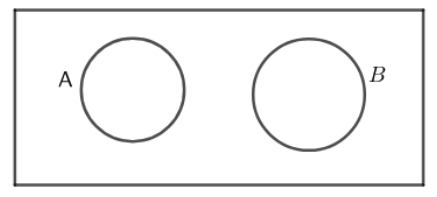
What are some examples of disjoint events?
Answer
512.4k+ views
Hint: We must first clearly understand the terminology used, and the meaning of disjoint events. We know that if the intersection of both events is null, then those events are called disjoint events. Now, we can easily figure out some basic examples based on our daily life experiences.
Complete step by step solution:
We know that if two events A and B are connected with a random experiment E, then these two events are said to be disjoint events if these two events, under any circumstances, cannot occur simultaneously.
In other words, we can say that the event A and B are disjoint events, if the probability of occurrence of A intersection B is zero, that is, $A\bigcap B$ is a null event.
We also know that two simple events connected with a random experiment are always disjoint events, but two compound events may or may not be disjoint.
We can understand this better with the help of following figure,

In the above figure, we can see that
$A\bigcap B=\phi $
And, so the events A and B are disjoint events.
Some examples of disjoint events are listed below.
Suppose a fair dice is rolled, and event A is the occurrence of an odd number and event B is the occurrence of an even number. We know that there is no number that can be both even and odd. Thus, the events A and B are disjoint events.
Suppose a fair coin is tossed, and event A is the occurrence of a head and event B is the occurrence of a tail. We know that heads and tails both cannot appear at the same time when a coin is tossed. Thus, these two events are also disjoint events.
Note: We must be very clear that though disjoint events seem very similar to independent events, both of these terms are different and used in different contexts. Also, we must remember that disjoint events are also called mutually exclusive events.
Complete step by step solution:
We know that if two events A and B are connected with a random experiment E, then these two events are said to be disjoint events if these two events, under any circumstances, cannot occur simultaneously.
In other words, we can say that the event A and B are disjoint events, if the probability of occurrence of A intersection B is zero, that is, $A\bigcap B$ is a null event.
We also know that two simple events connected with a random experiment are always disjoint events, but two compound events may or may not be disjoint.
We can understand this better with the help of following figure,

In the above figure, we can see that
$A\bigcap B=\phi $
And, so the events A and B are disjoint events.
Some examples of disjoint events are listed below.
Suppose a fair dice is rolled, and event A is the occurrence of an odd number and event B is the occurrence of an even number. We know that there is no number that can be both even and odd. Thus, the events A and B are disjoint events.
Suppose a fair coin is tossed, and event A is the occurrence of a head and event B is the occurrence of a tail. We know that heads and tails both cannot appear at the same time when a coin is tossed. Thus, these two events are also disjoint events.
Note: We must be very clear that though disjoint events seem very similar to independent events, both of these terms are different and used in different contexts. Also, we must remember that disjoint events are also called mutually exclusive events.
Recently Updated Pages
Why are manures considered better than fertilizers class 11 biology CBSE

Find the coordinates of the midpoint of the line segment class 11 maths CBSE

Distinguish between static friction limiting friction class 11 physics CBSE

The Chairman of the constituent Assembly was A Jawaharlal class 11 social science CBSE

The first National Commission on Labour NCL submitted class 11 social science CBSE

Number of all subshell of n + l 7 is A 4 B 5 C 6 D class 11 chemistry CBSE

Trending doubts
What is meant by exothermic and endothermic reactions class 11 chemistry CBSE

10 examples of friction in our daily life

One Metric ton is equal to kg A 10000 B 1000 C 100 class 11 physics CBSE

1 Quintal is equal to a 110 kg b 10 kg c 100kg d 1000 class 11 physics CBSE

Difference Between Prokaryotic Cells and Eukaryotic Cells

What are Quantum numbers Explain the quantum number class 11 chemistry CBSE




